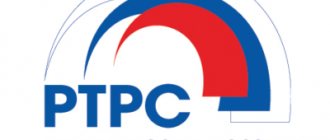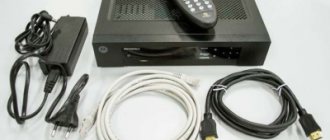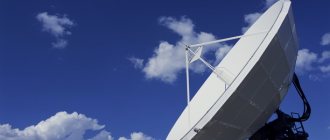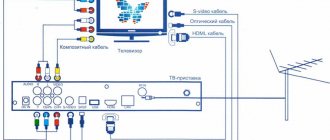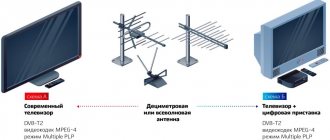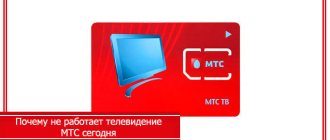Free DVB-T2 digital television channels are received from the Ostankino television tower and local repeaters. The main three frequencies for tuning by number: 30 - 546 MHz, 24 - 498 MHz, 34 - 578 MHz. Also, several more frequencies are used in the Moscow region; you can find a list of transmitters with their parameters on the coverage area page, and here is a prevention schedule. How many digital channels are tuned in your area depends on where the antenna is pointed, because... 30 units come from Ostankino, and only 20 from other TV towers. There are no plans to increase the number to three multiplexes on local towers. There are no pay TV or scrambled channels available.
What is digital television and how does it differ from analogue
The main operating principle of analog TV is that one channel completely occupies one frequency.
If digital broadcasting is used, then several channels can operate simultaneously on the same frequency, which are part of the so-called multiplex.
A multiplex is a group of TV channels that broadcast on the same frequency.
The digital signal always broadcasts without interference. A large number of additional services are available to viewers. But new technology requires additional equipment.
Advantages of digital television
The main advantage of the new technology is that it provides high picture quality and clear sound in HD quality. The quality of the image that is formed by an analog signal today has reached what is called its “ceiling”. A number doesn’t just paint a good “picture”; it has certain prospects for improvement.
The transition to digital opens up a world of new opportunities for TV viewers that are simply not available on analog TV.
The technology allows you to transmit sound and pictures at radio wave frequencies in the form of different streams. This is somewhat reminiscent of the connection between the Internet and a computer or tablet. Therefore, some compare the operation of digital TV with using the YouTube service on electronic devices.
This algorithm allows providers to send many more television programs to viewers at a lower cost. Therefore, the first thing users notice is a large number of channels. And the functionality of a simple TV is becoming wider: now you can pause any program or record it on a flash drive.
- image in HD quality;
- rich and clear sound;
- broadcasting a large number of TV channels;
- the ability to watch any program in different languages;
- blocking TV channels that are inappropriate for your family.
Another undeniable advantage is that you can find a large number of free multiplexes on the Internet. This means that a simple setup will help you watch your favorite TV channels for free.
On which TVs can you watch digital TV?
RTRS specialists claim that for Russian residents the transition to new technology will be minimal in cost. Without a subscription fee, everyone gets free access to a package of 20 top TV channels. To some this may not seem like much. But usually, owners of paid packages that include more than a hundred channels watch only a few of them. So these 20 are usually quite enough.
In principle, any TV is suitable for connecting digital television. It's just that different devices support different connection methods.
To put it simply, newer models are easier to connect to digital TV. Difficulties usually arise among owners of old TVs with a built-in kinescope. Most of these devices were produced even before domestic television entered the era of digitalization.
But even these “old-timers” are able to show “digits”. There are three generations of TVs:
- The newest flat models that work according to the DVB-T2 standard. They are already equipped with all the necessary equipment. The receiver is built directly into the device body. Therefore, to watch digital broadcasts, you just need to plug in the cable from the antenna.
- Flat-panel TVs that were released before 2013 may not have a receiver built into the body. To determine whether you have it, read the device datasheet. There should be information about DVB-T2 support. If this standard is not mentioned, then you will have to buy a separate set-top box.
- And even more so, you will need an attachment for the good old kinescope. And this set-top box must support DVB-T2. On one side, an antenna is connected to it, and on the other, your TV.
What's the problem with digital television?
According to statistics, in Russia more than a third of all home TVs do not support digital signal reception. We are talking not only about CRT “dinosaurs”, but also about quite high-quality and expensive LED models from 5-6 years ago.
Televisions supporting the DVB-T2 appeared on the domestic market only in 2012; Philips and Samsung began importing them. Therefore, if your TV was purchased before 2012, it is very likely that it does not support digital television. Here's how to find out exactly:
- You can find out whether your broadcast is digital or analogue right now by simply turning on the Russia-1 . If the TV is receiving an analog signal, there will be an “A” next to the channel logo.
- In order to find out whether your TV can be switched to digital reception, open the instructions and find out whether the technical specifications indicate the presence of a built-in tuner for receiving the DVB-T/T2 MPEG-4 digital standard.
This might be interesting:
- How to make an antenna for digital television with your own hands
What equipment is needed to connect?
The transition to digital TV involves the use of new equipment. If your TV already has a built-in adapter that supports T2, then the costs will be minimal. As a rule, all modern models produced since 2013 support digital well.
READ List of 20 free digital TV channels and instructions for setting them up
So where to start? If you live in an apartment building and use a shared antenna, you first need to check whether it supports digital broadcasting. Ask your neighbors: perhaps they have already switched to new technologies a long time ago. In this case, you can be sure that the antenna is suitable and there is no need to change it.
Then check the TV's passport to see if it supports the DVB-T2 standard. If yes, then you won’t have to purchase a receiver. All that remains is to connect everything using a cable and configure it.
So, what equipment is needed to watch digital?
Antenna
If there is a television tower near your house, then the signal can be received by the most ordinary home decimeter antenna. Otherwise, it is better to purchase a more powerful receiver. For a better signal, it is better to buy a directional antenna and place it towards the tower.
An antenna is not needed if you are connected to cable TV service. In this case, you can enter into an agreement with the service provider for free access to 20 public channels. There is no need to purchase an antenna if you use a satellite dish.
Amplifier
Many people are used to using an amplifier. Don't rush to abandon this device. A good amplifier will allow you to receive a high-quality signal even in remote places. But you need to remember that broadband antennas are capable of amplifying not only the T2 radio frequency range, but also all other radio waves operating at similar frequencies. And this can sometimes interfere with decoding the desired TV signal. Therefore, if digital works well without additional devices, it is not necessary to amplify the signal.
Many buyers, out of habit, buy devices with a power supply of 12 V. But the latest receivers operating according to the T2 standard produce a voltage of only 5 V. Therefore, it will be practical to purchase a device that operates on a voltage of 5 V.
Tuner
Without a tuner (or receiver) it is impossible to receive digital broadcasts. It decodes the signal to show it on TV. Modern consoles are very easy to use and practical. They usually only have one or two buttons and a simple remote control.
On the reverse side there is an interface for connecting an antenna and a TV. To connect to a TV, it is preferable to use the HDMI port. Otherwise, you will not be able to watch TV channels in HD quality.
Cables
To establish the interaction of all equipment, it is necessary to use special cables. Which “wires” to buy depends on the model of your TV.
Older devices can receive a signal from the receiver via an RCA tulip. A Scart input may also work. If you have a modern TV model, then it is better to use an HDMI cable that can provide the best picture and sound quality. Connecting using an outdated interface will only allow you to get the same image quality as with analog television.
By the way, don’t rush to run to the store to buy something. Often set-top boxes are already equipped with all the necessary cables.
Connection instructions
If you have an old TV model, then to ensure the “digital” operation you need to use a special set-top box. Modern models are equipped with T2 receivers. Therefore, you don’t need to buy anything extra for them. Make sure your device supports the MPEG-4 standard, which is valid in our country.
How to connect digital television to your TV yourself? There are two ways:
- Using a regular antenna.
- Using cable TV service.
The first option is more practical and requires less cost. If your home does not have a common antenna, then you will have to take care of choosing and purchasing this device.
For residents of Russia, two free multiplexes are currently available, allowing you to view about 20 channels. If you purchase cable television, you will have to pay monthly for this service.
Some write that a new free multiplex will soon begin broadcasting. So the number of available channels can be significantly increased. But this information is still in the air, and there is no concrete data. Therefore, for now we can classify it as a good rumor.
And now we can consider the nuances of the transition from analogue to digital TV. Let's look at five basic steps.
Step 1: purchase and installation of an antenna
If you want to set up digital TV yourself, you first need to take care of choosing an antenna. Keep in mind that there is no single universal model, so you will have to take into account the individual characteristics of housing. Also keep in mind that even in the most remote areas you can always install a device that will pick up the signal.
The most attractive option is a simple home antenna. But usually, if the tower is located far away, its power may not be enough. Interference often occurs if a truck passes near the house.
READ Match! Country: a new channel starts broadcasting!
Even good amplifiers do not always provide high-quality reception, because the waves are dampened by external obstacles.
Therefore, a home antenna is suitable only if two conditions are met:
- There is a tower next to the housing.
- The window allows you to point the antenna directly at the tower.
A more effective option would be to use an external signal receiver. After all, the waves in this case are supplied to the devices without damping through the walls of the room.
Please also note that in most cases, using an inexpensive passive antenna is sufficient to achieve acceptable quality. However, if the distance to the set-top box or TV is far, and you have to stretch a long cable, active antennas equipped with their own amplifier do a better job.
Step 2: determining the direction where the tower is located
To find out where the nearest tower is, look at the digital broadcast map. In the special menu, write the name of your locality. After this, you can estimate at what distance and in what direction the tower is located in your area.
You can check whether a settlement is in the coverage area on the website - CETV Interactive Map.
Step 3: setting up equipment to receive a high-quality signal
The quality of the received signal is constantly affected by various external factors:
- weather;
- geomagnetic storms;
- unfavorable seasons;
- air temperature;
- air humidity indicators;
- change of time of day.
All this can enhance or suppress the signal. If the tower is in direct line of sight, then problems usually do not arise. The main thing is to place the antenna in the right direction.
If the TV tower is remote, then difficulties often arise in receiving the TV signal. There is a so-called confident zone of radio waves. Outside this zone, the waves are obscured by the surface of the earth, so additional effort must be made to tune the TV broadcast.
Officially, the government is making a lot of efforts to install new towers in the right places. But this process does not proceed as quickly as we would like. If in your area the nearest tower is far away, weather conditions will have a powerful impact on the quality of the TV signal.
Try to point the antenna directly towards the transmitter and fix it securely. Find the antenna with the most suitable design by calculating its size based on its maximum gain. Please consult your retailer regarding this issue when selecting the appropriate device.
Step 4: Setting up your TV
How to connect digital TV yourself?
First you need to connect the antenna to the TV receiver using a cable. If you have a modern TV, plug the cable directly into it. If the TV is powered by a set-top box, then the antenna cable is connected to the receiver's socket.
The setup procedure in the TV menu is simple and does not cause any difficulties. But it can differ significantly for different devices. Therefore, you need to find the instruction manual for your TV and follow the steps in it.
Usually, after the first launch, you can use the auto-installation function. Most often, this is enough to establish signal reception from the antenna via cable.
Step 5: Search for channels
The easiest way to find channels is to use the automatic tuning feature. Each device enables this feature differently. Therefore, use the operating instructions for your TV model.
Until the auto search is completed, do not turn off the TV. If you can't find channels, most likely the receiver is not receiving a signal from the antenna. It may also be that the antenna is not receiving a signal. Try changing its direction, and then start the auto search again.
Sometimes users prefer to use manual search. A list appears on the TV screen into which data on the broadcast frequency is entered. Manual adjustment allows you to achieve the best picture quality in situations where auto search cannot cope with this task.
Third multiplex of digital channels
On the third multiplex, programs are shown in a certain order, on each button there are several TV channels that replace each other. This is a way to avoid advertising laws. The channels, at their own expense, organized the broadcast of the third multiplex in Moscow and the Ostankino region, accumulate the required number of hours of free broadcasting and after that have the right to include advertising in their programs.
| Position | Channel logo | Name | Number | Frequency (MHz) | Broadcast time |
| 1 | TNT MUSIC | 34 | 578 | 00:00 — 24:00 | |
| 2 | 2×2 | 34 | 578 | 00:00 — 12:00 | |
| My planet | 34 | 578 | 12:00 — 18:00 | ||
| The science | 34 | 578 | 18:00 — 24:00 | ||
| 3 | Tlum HD | 34 | 578 | 00:00 — 05:00 | |
| FAN | 34 | 578 | 05:00 — 10:00 | ||
| Russian detective | 34 | 578 | 10:00 — 15:00 | ||
| TV channel "History" | 34 | 578 | 15:00 — 20:00 | ||
| Ani | 34 | 578 | 20:00 — 24:00 | ||
| 4 | Sundress | 34 | 578 | 00:00 — 12:00 | |
| Cartoon and music | 34 | 578 | 12:00 — 24:00 | ||
| 5 | NST | 34 | 578 | 00:00 — 03:00 | |
| Cinema | 34 | 578 | 03:00 — 06:00 | ||
| Planet HD | 34 | 578 | 06:00 — 09:00 | ||
| Doctor | 34 | 578 | 09:00 — 12:00 | ||
| Techno 24 | 34 | 578 | 12:00 — 15:00 | ||
| Mother | 34 | 578 | 15:00 — 18:00 | ||
| Living Planet | 34 | 578 | 18:00 — 24:00 | ||
| 6 | Moscow Trust | 34 | 578 | 00:00 — 12:00 | |
| Euronews | 34 | 578 | 12:00 — 24:00 | ||
| 7 | Home Cinema | 34 | 578 | 01:30 — 02:30 | |
| Time | 34 | 578 | 02:30 — 04:30 | ||
| TV cafe | 34 | 578 | 04:30 — 06:30 | ||
| Beaver | 34 | 578 | 06:30 — 08:30 | ||
| Music of the First | 34 | 578 | 08:30 — 01:30 | ||
| 8 | 365 days of TV | 34 | 578 | 00:00 — 02:00 | |
| TNT-4 | 34 | 578 | 02:00 — 04:00 | ||
| Film series | 34 | 578 | 04:00 — 06:00 | ||
| HD Life | 34 | 578 | 06:00 — 08:00 | ||
| ZEE TV | 34 | 578 | 08:00 — 10:00 | ||
| Indian film | 34 | 578 | 10:00 — 12:00 | ||
| Movie date | 34 | 578 | 12:00 — 14:00 | ||
| Comedy film | 34 | 578 | 14:00 — 16:00 | ||
| Kinomix | 34 | 578 | 16:00 — 18:00 | ||
| Men's cinema | 34 | 578 | 18:00 — 20:00 | ||
| Kitchen TV | 34 | 578 | 20:00 — 22:00 | ||
| Auto Plus | 34 | 578 | 22:00 — 24:00 | ||
| 9 | News | 34 | 578 | 00:00 — 24:00 | |
| 10 | Match Premier | 34 | 578 | Blocked |
If the indicated frequencies are not received or you do not know which direction to point the antenna, find your exact location on the interactive DTV map and click on it, the map will show in which direction the nearest tower is and at what frequency it broadcasts.
Common Questions
How to connect two TVs to one set-top box?
It would be correct to purchase a separate set-top box for each TV. It is not very expensive and will allow you to watch different channels simultaneously on two different devices. But if there is still a reason to use one receiver, then to connect different TVs you just need to use all available interfaces. An HDMI cable is pulled to one TV, and a “tulip” cable to the second. With this connection scheme, both devices will display the same channel.
Do I need to buy a new TV?
Not necessary. Modern models, as a rule, support the DVB-T2 standard and can process the MPEG4 format. If your device is already outdated, then to expand its capabilities you can purchase an inexpensive set-top box that supports modern technologies.
Is it possible to receive digital broadcasts via a satellite dish?
No, It is Immpossible. Satellite television operates according to the DVB-S standard - this is a completely different technology.
Will analogue broadcasting be switched off?
Yes, it will. In 2021, the transition to digital broadcasting will be completely completed throughout the country, and the transmission of analogue signals will be stopped.
What channels are available for free viewing?
We offer you a table of 20 mandatory free channels for all of Russia.
| Position | Channel |
| 1 | First channel |
| 2 | Russia |
| 3 | Match TV |
| 4 | NTV |
| 5 | St. Petersburg (channel 5) |
| 6 | Russia - Culture |
| 7 | Russia 24 |
| 8 | Carousel |
| 9 | Public television of Russia |
| 10 | TV CENTER |
| 11 | REN-TV |
| 12 | Saved |
| 13 | STS |
| 14 | Home |
| 15 | TV-3 |
| 16 | FRIDAY |
| 17 | STAR |
| 18 | WORLD |
| 19 | TNT |
| 20 | MUZ |
Second multiplex of digital channels
| Channel logo | Name | Number | Frequency (MHz) |
| REN TV | 24 | 498 | |
| SAVED | 24 | 498 | |
| STS | 24 | 498 | |
| Home | 24 | 498 | |
| TV3 | 24 | 498 | |
| Friday | 24 | 498 | |
| Star | 24 | 498 | |
| WORLD | 24 | 498 | |
| TNT | 24 | 498 | |
| Muz TV | 24 | 498 |
